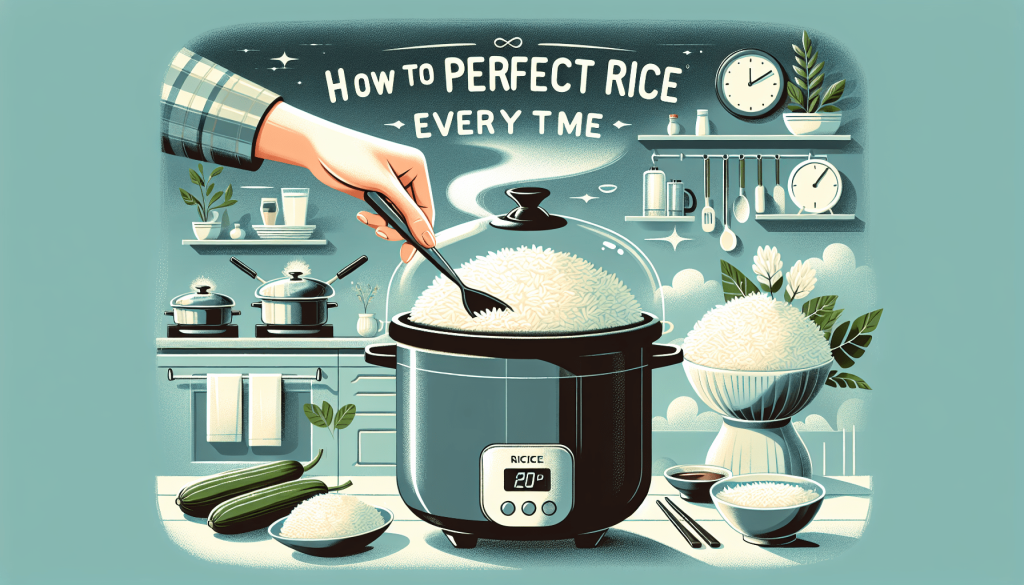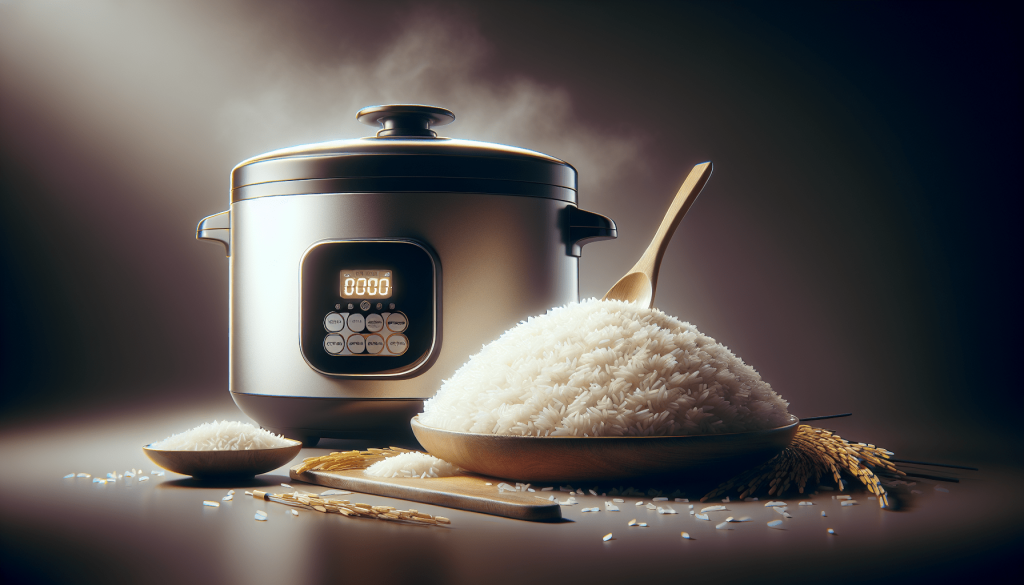So you want to know the secret to cooking perfect rice every time? Look no further! This article will guide you through the steps to ensure that your rice turns out fluffy, tender, and delicious, without fail. Whether you’re a novice in the kitchen or an experienced home cook, these tips and tricks will have you serving up perfect rice that will impress your family and friends. Say goodbye to sticky or mushy rice, and get ready to elevate your rice-cooking game to a whole new level!

Choose the Right Rice
To cook perfect rice, the first step is to choose the right type of rice for your dish. There are several different types of rice available, each with its own unique characteristics and uses. Here are some of the most common types of rice:
- Long-grain rice: This type of rice has slender grains and tends to stay separate and fluffy when cooked. It is ideal for dishes like pilaf, stir-fries, and salads.
- Short-grain rice: Short-grain rice has a plump and starchy texture, making it perfect for dishes like sushi, risotto, and rice pudding.
- Basmati rice: Basmati rice is a fragrant and aromatic long-grain rice commonly used in Indian and Middle Eastern cuisine. It is known for its delicate flavor and fluffy texture.
- Jasmine rice: Jasmine rice is another variety of fragrant long-grain rice, popular in Southeast Asian cooking. It has a subtle floral aroma and a slightly sticky texture when cooked.
When choosing rice, consider the specific dish you are preparing. For example, if you are making a stir-fry, long-grain rice would be a good choice, as it will stay separate and not clump together. On the other hand, if you are making sushi, you would want to use short-grain rice for its stickiness.
Additionally, consider the cooking time and texture of the rice. Some types of rice, like brown rice, require longer cooking times and more water compared to white rice. Understanding these differences will help you choose the perfect rice for your dish.
Rinse the Rice
Before cooking rice, it is important to rinse it to remove any excess starch or debris. Here’s how to rinse rice properly:
- Measure the desired amount of rice using a measuring cup. The standard ratio is 1 cup of rice to 1.5 to 2 cups of water, depending on the type of rice and personal preference.
- Place the rice in a fine-mesh strainer to prevent the grains from falling through.
- Rinse the rice thoroughly under cold water, gently swishing it around with your hands. This will help remove any surface starch and impurities.
- Continue rinsing until the water runs clear. This indicates that the rice is clean and ready to be cooked.
Rinsing the rice not only removes impurities but also helps to prevent it from becoming sticky or clumpy when cooked. This step is especially important for certain types of rice, such as sushi rice, which needs to be rinsed thoroughly to achieve the desired texture.
Use the Correct Water-to-Rice Ratio
The water-to-rice ratio is crucial for achieving perfectly cooked rice. While the amount of water may vary slightly depending on personal preference and the specific type of rice being used, here are some general guidelines for common types of rice:
- For white rice: Use a 1:1.5 or 1:2 ratio of rice to water. This means if you have 1 cup of rice, you would use 1.5 to 2 cups of water.
- For brown rice: Use a 1:2 or 1:2.5 ratio of rice to water. So, if you have 1 cup of brown rice, you would use 2 to 2.5 cups of water.
The ratio may need to be adjusted slightly based on personal preference and the desired texture of the cooked rice. Some people prefer their rice to be slightly softer, while others prefer it to be more al dente. Experimenting with the ratio will help you find the perfect balance that suits your taste.
Soak the Rice (Optional)
While soaking rice is not always necessary, it can help to improve the texture and taste of certain types of rice. Soaking rice makes the grains more tender and can reduce cooking time. Here’s how to soak rice:
- Measure the desired amount of rice and place it in a bowl.
- Add enough water to completely submerge the rice.
- Allow the rice to soak for 30 minutes to 2 hours. The longer the soaking time, the softer the rice will become.
- After soaking, drain the rice thoroughly before cooking.
Soaking rice is especially beneficial for long-grain and brown rice, as it helps to loosen the grain structure and reduce the cooking time. However, keep in mind that soaking is not necessary for all types of rice, so it’s up to personal preference whether or not to incorporate this step into your cooking routine.

Choose the Right Cooking Method
There are several different methods you can use to cook rice, including stovetop, oven, and rice cooker. Each method has its own advantages and may be better suited for different types of rice or personal preferences. Here’s an overview of each method:
-
Stovetop Method: This is the most traditional and commonly used method for cooking rice. Here’s how to cook rice on the stovetop:
- Use a heavy-bottomed pot with a tight-fitting lid to ensure even heat distribution and prevent steam from escaping.
- Add the rinsed rice and the appropriate amount of water to the pot.
- Bring the water to a boil over high heat.
- Once the water is boiling, reduce the heat to low and cover the pot with the lid.
- Cook the rice for the recommended time, without lifting the lid or stirring.
-
Oven Method: The oven method is a convenient option if you need to cook a large batch of rice or if you want a hands-off approach. Here’s how to cook rice in the oven:
- Preheat the oven to the appropriate temperature according to the package instructions or recipe.
- Place the rinsed rice and the correct amount of water in an oven-safe dish with a tight-fitting lid.
- Cover the dish tightly with foil or the lid to trap the steam.
- Place the dish in the preheated oven and cook for the recommended time.
-
Rice Cooker: Using a rice cooker is the easiest and most foolproof way to cook rice. Rice cookers are specifically designed to cook rice to perfection with minimal effort. Here’s how to cook rice in a rice cooker:
- Follow the manufacturer’s instructions for your specific rice cooker.
- Add the rinsed rice and the appropriate amount of water to the rice cooker.
- Close the lid and select the appropriate cooking setting.
- Press the cook button and wait for the rice cooker to finish cooking.
Choosing the right cooking method will depend on your preferences, the type of rice being used, and the equipment available to you. All three methods can produce deliciously cooked rice, so choose the one that fits your needs best.
Cook the Rice
Once you have chosen the cooking method, it’s time to cook the rice. Here’s a step-by-step guide for each cooking method:
-
Stovetop Method:
- Bring the water to a boil over high heat.
- Once the water is boiling, reduce the heat to low and cover the pot with the lid.
- Cook the rice for the recommended time without lifting the lid or stirring. The cooking time will vary depending on the type of rice and the desired texture.
-
Oven Method:
- Preheat the oven to the appropriate temperature according to the package instructions or recipe.
- Place the dish with the rice and water in the preheated oven.
- Cook the rice for the recommended time. The cooking time will depend on the type of rice and the desired texture.
-
Rice Cooker:
- Follow the manufacturer’s instructions for your specific rice cooker.
- Press the cook button and wait for the rice cooker to finish cooking. The cooking time will be automatically determined by the rice cooker.
During the cooking process, it is important to resist the temptation to lift the lid or stir the rice, as this can result in uneven cooking and loss of steam, which is essential for achieving the perfect texture.
Let the Rice Rest
After the rice has finished cooking, it’s important to let it rest for a few minutes before serving. This resting period allows the rice to finish steaming and allows the moisture to distribute evenly throughout the grains. Here’s what to do:
- Remove the pot from the heat or turn off the oven/rice cooker.
- Keep the lid on and let the rice rest for 5-10 minutes.
During this resting period, the residual heat inside the pot continues to cook the rice gently while the steam works its way through the grains. The result is fluffier and more evenly cooked rice.
Fluff the Rice
To achieve light and fluffy rice, it’s important to fluff it before serving. Fluffing the rice helps separate the grains and releases excess steam. Here’s how to fluff the rice:
- Use a fork or a rice paddle to gently fluff the rice.
- Gently separate the grains, taking care not to mash the rice.
- Fluffing the rice right before serving will give it a light and airy texture.
The purpose of fluffing is to loosen any clumps or stickiness that may have developed during the cooking process. By gently fluffing the rice, you’ll ensure that it is light, fluffy, and free from clumps.
Serve and Enjoy
Now that your rice has been perfectly cooked, it’s time to enjoy it! Cooked rice makes a delicious side dish or can be incorporated into various recipes as a main meal. Pair your cooked rice with your favorite dishes, such as stir-fries, curries, stews, or even as a simple side to grilled meat or vegetables. The possibilities are endless.
Remember, the key to perfectly cooked rice is choosing the right type of rice, rinsing it properly, using the correct water-to-rice ratio, and selecting the cooking method that works best for you. With a little practice and experimentation, you’ll be able to consistently cook delicious rice every time.
Experiment and Adjust
Cooking rice is not an exact science, and everyone has different preferences when it comes to the texture and taste of rice. It’s important to experiment and adjust the cooking process to find what works best for you. Here are some areas where you can experiment:
- Try different types of rice: Each type of rice has its own unique flavor and texture. Experiment with different varieties to find your favorite.
- Experiment with soaking times: Soaking rice can impact the texture and cooking time. Try soaking for different lengths of time to see how it affects the final result.
- Adjust the water-to-rice ratio: If you prefer your rice to be softer or firmer, you can adjust the water-to-rice ratio slightly. Start with the recommended ratio and make small adjustments based on your preferences.
- Find the method that works best for you: While the stovetop, oven, and rice cooker methods all produce delicious rice, you may find that one method yields better results for you. Experiment with different methods to find which one you prefer.
By embracing experimentation and making adjustments to your cooking process, you’ll be able to consistently cook rice that meets your personal preferences and satisfies your taste buds. Enjoy the journey of discovering your perfect rice-cooking method!
